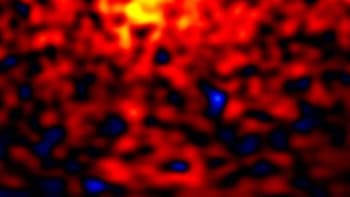
Hypothetical particles called ultralight bosons could be spotted lurking near supermassive black holes by the Laser Interferometer Space Antenna (LISA), according to calculations by a team of astrophysicists. LISA is a space-based gravitational-wave detector that should be operational in 2034, when the team says it could determine whether ultralight bosons are a component of dark matter.
According to the conventional model of the universe, about 85% of its mass is dark matter. This mysterious substance neither emits nor absorbs electromagnetic radiation and physicists have little idea of its composition. One possibility is that dark matter is made of ultralight bosons such as axions, which are not part of the Standard Model of particle physics. Now Tjonnie Li of the Chinese University of Hong Kong and an international team have shown that LISA may be able to detect or rule out the existence of ultralight bosons by looking at gravitational wave signals from supermassive black holes.
If ultralight bosons exist, calculations suggest that clouds of them will form outside the event horizon of spinning supermassive black holes, which reside at the centres of many galaxies. Like other particles, these hypothetical ultralight bosons must have a Compton wavelength, which is a quantum-mechanical property of a particle that is inversely proportional to its mass. Because ultralight bosons have very small masses, they would have relatively large Compton wavelengths.
Superradiance
An interesting effect called superradiance should occur if the Compton wavelength of ultralight bosons is comparable to the Schwarzschild radius of the black hole (the distance from the centre to the event horizon). The boson field couples to the spinning black hole and extracts energy from it until the boson cloud is rotating with comparable velocity to the black hole. Superradiance was first predicted in 1971 by the Soviet physicist Yakov Zel’dovich for a spinning metal cylinder in an electromagnetic field. “If it exists for a spinning cylinder, it also exists for a spinning black hole,” explains gravitational astrophysicist Vitor Cardoso of the Center for Astrophysics and Gravitation in Lisbon — who was not involved in this latest research.
This transfer of energy from a supermassive black hole to a surrounding cloud of ultralight bosons would alter the black hole’s gravitational wave signal. Researchers have already suggested that this could be used to identify ultralight bosons and measure their mass, but Li points out that this would be very difficult to do using existing ground-based detectors.
Now, Li and colleagues have outlined a protocol whereby LISA could potentially settle the debate over ultralight bosons by avoiding much of the noise that limits ground-based detectors such as LIGO. More importantly, LISA should detect low-frequency gravitational waves produced by supermassive black holes with Schwarzchild radii between 1000-1,000,000 km. There is some evidence that dark matter could comprise ultralight bosons with Compton wavelengths of this order and therefore superradiant coupling between the black hole and the hypothetical boson cloud should cause a reduction in the spin of the black hole.
Black hole geometry
“If we measure the black hole geometry – such as we can with gravitational waves – it will give us a prediction for what the bosonic cloud looks like,” explains Li’s PhD student Otto Hannuksela, who led the research. “The black hole geometry with the bosonic cloud already encodes some information about the boson particle.”
According to Li, even more information could be gleaned from gravitational waves if a smaller black hole happened to be spiralling into the supermassive black hole. “With LISA, we can track the orbit of the smaller black hole over timescales of years.” As the smaller black hole orbits, it would pass through any bosonic cloud surrounding the larger black hole. This would alter the orbit, and consequently the gravitational wave signal of the smaller black hole. This could provide a completely independent measurement of the shape of the larger black hole’s bosonic cloud. If the shape of the cloud inferred from the small black hole orbit were consistent with the shape predicted from the large black hole geometry, this could verify the existence of the bosonic cloud and therefore the light boson hypothesis. Otherwise, it could rule out ultralight bosons.
“I think it’s a very important question to ask and I think they have a very important set of tools to discriminate [the existence of light bosons],” says Cardoso. Nevertheless, he notes that the researchers have modelled the orbits using simple Newtonian gravity rather than full general relativity, and have neglected two other important influences on a smaller black hole spiralling into a supermassive one. Therefore, he says, “we don’t yet know whether we can really tell precisely whether such a cloud exists.”
The calculations are described in Nature Astronomy.



